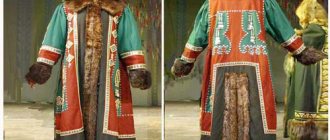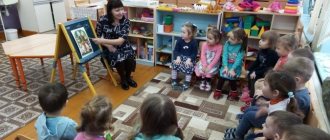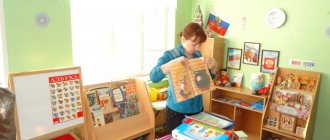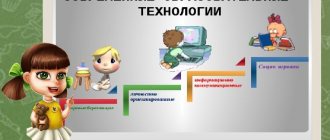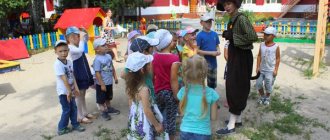MAGAZINE Preschooler.RF
Patriotic quest game “Raising a little patriot”Purpose of the game:
- To improve the work of MADOU in the civic and patriotic education of preschool children.
- To stimulate the need of teachers to demonstrate creativity and introduce new Federal State Educational Standards for the successful education of preschoolers.
- Develop the ability to discuss and agree on proposed issues.
Rules of the game:
- Take an active part in the game.
- Be able to listen to others.
- Develop a common solution to the issue.
- Maintain proper speech culture and tact.
- Do not evaluate jury scores.
PROGRESS OF THE GAME
Preschool childhood is the most important period in the formation of a person’s personality. At this age stage, the moral foundations of civic qualities are laid, and children’s first ideas about the world around them, society and culture are formed.
Patriotic education is aimed at the formation and development of an individual who has the qualities of a citizen-patriot of the Motherland and is capable of successfully fulfilling civic duties in times of peace and war. You cannot be a patriot without feeling a personal connection with your Motherland, without knowing how our ancestors, our fathers and grandfathers loved and cherished it.
Patriotism in relation to a preschool child is the need to participate in all matters for the benefit of the people around him, representatives of wildlife, the presence of such qualities as compassion, empathy, self-esteem; awareness of oneself as a part of the surrounding world.
In addition to patriotic feelings, an important element in becoming a young citizen is awareness of one’s ethnicity.
And any awareness begins with KNOWLEDGE. Knowledge about who I am, what the people are, what my people are, what their history, culture, traditions are...
1. Game “Let's stand in twos” .
Goal: distribution of players into teams.
Progress of the game: Music sounds. All players move, and the Leader calls the number 2 (4, 6). Everyone is built in pairs.
Host: You are divided into fours - these will be the teams. I invite the teams to go to their tables. Please choose your team captains and come up with a team name. According to tradition, we need to select the jury for today's game.
1. Training on creating the image “Motherland” .
I propose to create an image of the Motherland.
- close your eyes, imagine the image that appears when you hear the word “Motherland” . (teachers describe the images that arose: birch, open field, etc.);
- exchanging opinions, listening to folk songs and watching the video “Pictures of Native Nature” ;
- development of the general concept of “Motherland” ;
- selection of related words for the word “Motherland” (Motherland, clan, people, parents, portly, beard, spring).
Interesting fact: Beard is a word related to “Motherland” . It has been proven that hair contains the genetic memory of the family. Therefore, a woman wearing a braid should not cut her hair during pregnancy; through the braid, she passes on the ancestral memory to the child. No wonder the braid looks like a DNA helix. And men kept their ancestral memory in their beards. Therefore, in Rus', men always wore a beard.
Returning to the topic of our seminar “Moral and Patriotic Education” , we can say that each clan, like a people, should have a specific place, its own piece of the Motherland. This is the land from which the family tree grows. And this piece should be passed down by inheritance. It cannot be sold or exchanged. The commandments of the god Perun say: “Do not sell your land for gold and silver, for you will call curses on yourself, and you will not be forgiven all your days without a trace...” .
2. Brainstorming .
Host: And now we will do a little warm-up. Answer the questions given to you.
Questions for teachers:
- How do you understand what moral and patriotic education is? (This is the education of love for the Motherland, oneself, loved ones, and the environment).
- Formulate the goal of moral and patriotic education of preschool children. (Education of a humane, spiritual and moral personality, worthy future citizens of Russia, patriots of their Fatherland).
- Formulate the tasks of moral and patriotic education of preschool children.
- Forming a sense of attachment to your home, kindergarten, friends, your loved ones;
- Formation of a feeling of love for one’s native land, one’s small homeland based on familiarization with one’s native nature, culture and traditions;
- Formation of ideas about the Motherland as a native country, about Moscow as the capital of Russia;
- Fostering patriotism and respect for the cultural past of Russia through the means of aesthetic education: music, artistic activity, artistic expression;
- Cultivating a moral and patriotic feeling through the study of Russian state symbols.
- Fostering a sense of respect for elders.
4. Draw up a scheme for the implementation of work on moral and patriotic education with preschool children (educators are asked to fill out the schemes proposed to them. Then the Leader fills out the general scheme on the board for verification).
3. Game “Attentive Eyes” .
Host: And now we will test your powers of observation and how your moral and patriotic feelings are developed. Remember and answer the questions:
- Describe the coat of arms of Russia. (We don’t know exactly why the tsar chose a combination of white, blue and red colors. Perhaps he used the ancient coat of arms of the Moscow princes: white - St. George the Victorious, blue - the flowing cloak of the horseman, red - the background, the shield of the coat of arms.)
- How many crowns do eagles have on the coat of arms of Russia? (Three. They are yellow, and this is the color of the sun. For us, yellow has always symbolized goodness and justice)
- What does the eagle hold in its right paw? (scepter)
- What is the eagle holding in its left paw? (rod. These are symbols of power)
- What else is depicted on the coat of arms? (St. George the Victorious. Our coat of arms symbolizes the victory of good over evil)
- What is he holding in his hand? (Spear. From this spear the penny got its name)
- What shape do coats of arms have? (shield)
Host: Let's check the correctness of your answers (shows an illustration of the Coat of Arms of Russia, the coat of arms of the village).
4 "Name it correctly".
1. A special political institution that provides social
protection of the population, defense and security of the country. (State)
2. A large territory that has certain boundaries and enjoys state sovereignty. (A country)
3. What is patriotism? (Devotion and love for the Motherland, its nature, culture, people)
4. Who founded Moscow? (Prince Yuri Dolgoruky, son of the Grand Duke of Kyiv Vladimir Vsevolodovich Monamakh)
5. What custom existed in the old days when entering the Kremlin through the gates of the Spasskaya Tower? (It was necessary to remove the hat; the violator was punished by forcing him to bow to the tower fifty times)
7. "Grandma's Chest"
- Where does the Motherland begin... with fairy tales, legends, epics, nursery rhymes, proverbs, sayings... From infancy, a child hears his native speech. Works of oral folk art not only form a love for the traditions of their people, but also contribute to the development of personality in the spirit of patriotism.
— On the pieces of paper there are proverbs from other countries with modern interpretations, I suggest you read them and remember the analogue of Russian proverbs that are already familiar to you. For example:
“The head is the crown of the body, and the eyes are the best diamonds in that crown” (Azerb.) - “The eyes are the mirror of the soul . If you guessed the proverb, then one is “patriotic”
Game: “Say a proverb in Russian”
— Translate a foreign proverb or saying into Russian, find an analogue:
“When a lady gets out of a car, the car goes faster” (English) - “A woman with a cart makes it easier for a mare .
“He who asks will not get lost” (Finnish) - . ”
| Next > |
Lesson - quest “Good deeds” in the senior group of preschool educational institutions
QUEST OF GOOD DEEDS in kindergarten
Author: Olga Vitalievna Shkodina, teacher-psychologist of preschool educational institution No. 4 of the combined type “Zhuravlenok”, Shakhtersk
A lesson in the form of an adventure game-quest (with completion of the rear) for children of senior preschool age, dedicated to the Day of Spontaneous Display of KINDNESS. GOAL: To generalize children’s idea of kindness as a valuable human quality, to develop social feelings and mutual assistance. Form friendly relationships, a conscious attitude towards social norms of behavior, develop cooperation and communication skills in everyday life. Improve cultural communication skills with peers by following speech etiquette. Create a positive emotional background in the children's team. OBJECTIVES: Educational: to reveal the essence of the concepts of “goodness” and “kindness”, “good deeds”; Speech: activate children's vocabulary (kindness, joy, happiness, care, attention); Developmental: develop children's logical thinking, imagination and attention, instill interest in a new form of gaming activity (quest game). Educational: to form children's idea of kindness, to cultivate good feelings towards the people around them, to help children understand that everyone needs love and a friendly attitude. PROGRESS OF THE LESSON Psychologist: Don’t be afraid to give warming words and do good deeds! The more wood you put on the fire, the more heat you will take.
Psychologist: Today is not an easy day for us, you and I will perform good tasks. Do you know what “kindness” is? Children's answers: these are such actions, this behavior, these are the smiles on their faces. Psychologist: What is the opposite word? "Evil" is correct. What kind of evil children are there? What are they doing? Children's answers: they fight, break toys, they have bad behavior, they don't listen... Psychologist: Who do you want to be? And to do this you need to complete tasks and complete the QUEST - this is an adventure game with tasks. Do you want to travel? And what tasks will we learn from this magic envelope? 1. TASK: “PASS A GOOD WORD!” “The good sun has risen again: we must say good morning!”
Psychologist: Who knows the proverbs about kindness:
Children: A good word heals, an evil word cripples. Kind words are more valuable than wealth. Good deeds are rewarded with good. It is not clothes that make a man, but his good deeds. Do not boast about silver, but rather boast about good things. Whoever does good will be rewarded by God. 2. TASK: “GUESS THE RIDDLE” They purify the air, Create comfort, Turn green on the windows, Bloom all year round.
Psychologist: That's right, these are flowers and you and I will go to the Winter Garden to do a good deed - we will take care of the flowers. Labor activity in the Winter Garden
3. TASK: “GIFT FOR BABIES” Let everyone in the world know that we are all kind children, we live in kindergarten: we play and draw, count and dance, laugh and sing. We live a fun life! Gift for kids “Ladybug”
4. TASK: “GUESS THE RIDDLE - COMPLETE THE TASK!” We will open a wonderland and meet the heroes in the lines on pieces of paper, where the stations are on the dots. (Book) Psychologist: That's right, guys, this is a book and now we'll go..... If you want to become smart, you need to read a lot of books. To find all the books of the century, Come to... Library Psychologist: That's right! We'll go do a good deed in our children's library! (group No. 10) Psychologist: Here’s a task we’ll help treat books for kids.
Manual labor “Let's glue the pages of the books” Librarian: I thank you for your good deed and invite you to get acquainted with the new book, but it is not easy. Psychologist: Thank you, but what is its mystery? Librarian: Good and evil heroes are collected here, but they are mixed up and need to be sorted into fairy tales. 5. TASK: “GUESS THE GOOD HEROES!” A fairy tale brings us good, those who know will understand! Guess the riddles
He treats little children, He treats birds and animals, The Good Doctor looks through his glasses... (Aibolit) He lives in Africa.
And he sings songs in a terrible voice. He's just a villain This is......(Barmaley) Wooden boy He makes noise like a drum, A favorite of adults and children, An inventor of all sorts of ideas, A long nose will show cleverly, Instead of a nose there is not a carrot! Who is this? (Pinocchio) An elderly man with a very long beard! He offends Pinocchio, Artemon and Malvina. Do any of you know who this is? (Karabas) I fly in a mortar - I kidnap children In a hut on a chicken's leg, I have a hooked nose, my eyes are stuck out. Who am I? (Baba Yaga) Everyone is waiting for him in winter, He is kind, he is not evil, He has a beard up to his eyes. Red-cheeked...(Santa Claus) In a fairy tale he was born gray, Everyone is afraid - like fire! All the little animals ran into the house and hid from me! Suddenly there was a menacing click of his teeth... Evil, terrible, gray... (Wolf) The Wolf offended these little children - he ate them, the villain! Only one survived, the Wolf did not get caught in his teeth. He told his mother everything, he showed all his brothers. Who are the gray ones? If you know, name it! (Little goats) He lived in a poultry house, he was afraid that the turkey was laughing at him, After all, no one knew that he was born a White Swan. (The Ugly Duckling) This is a hardworking girl, Very kind and very beautiful, Suddenly she’s going to the ball got caught, lost her shoe on the step. (Cinderella). Well done guys, you answered the riddles and you know all the fairy tales! Psychologist: I suggest you warm up a little. We are holding a physical session for E. Zheleznova
: “Let’s get down to business quickly, the work will be more fun, the adults will now see how each of us works.
We wipe dust everywhere, we even crawl under the table, and we’ll wipe it here, we’ll wipe it there, we’ll also find it under the sofa. We water the flowers together, and we don’t forget: We water one flower, and we water the second flower with cool water. We love sweeping the floor and we sweep it twice a day. We sweep, sweep, sweep, sweep, we don’t get tired one bit. Mom said: “I’ll wash the dishes without help. Like this, like this, like this, like this, I can’t wait.” 6. TASK: “HELP THE WINNER” Working on the street
It is not at all, not at all easy to be kind, Kindness does not depend on height, Kindness does not depend on color.
Kindness is not a carrot, not a candy. Kindness does not age over the years, Kindness will warm you from the cold, You just need to be kind and not forget each other in trouble. If kindness shines like the sun, adults and children rejoice. 7. TASK: ACTION “Do-it-yourself kindness” Psychologist: I have a chest to collect financial assistance for a little boy. We offer all adults to help with the baby's surgery.
Don't stand by indifferently when someone is in trouble. You need to rush to the rescue. Any minute, always. And if it helps anyone. Your kindness, your smile, You are happy that the day was not lived in vain, That the years you live are not in vain.
8. TASK: “COLLAGE OF GOOD DEEDS.” Psychologist: We will put everything we did today into the “Collage of Good Deeds” and receive these kindness medals for participating in the game!
Psychologist : All people need kindness, Let there be more kind ones. It’s not for nothing that they say “Good afternoon” and “Good evening” when meeting. And it’s not for nothing that we have the “Good Hour” wish. Kindness is the adornment of a person from time immemorial...
We recommend watching:
Scenario of sports leisure “Small Children's Olympic Games” in the senior group Scenario of the sports festival “Dad, Mom, I - a sports family” for children of the senior group with their parents Physical education leisure in the senior group of the kindergarten. Scenario: Leisure according to traffic rules in the senior group
Similar articles:
Summary of GCD in the preparatory group. In the land of kindness
Book name day in kindergarten. Scenario
Scenarios for holidays in the senior group of kindergarten
Physical education leisure in the senior group “Hello, Zimushka-Winter”
Physical education leisure in the senior group in kindergarten “Journey to the Land of Health”
Patriotic education quest “My city is my small Motherland”
Shakhtersk preschool educational institution of a combined type No. 6 “Rosinka” of the education department of the Shakhtersk city administration
Abstract of GCD for children of the senior group.
Quest “My city is my small Motherland.”
Educator
I quarter categories
Kochura N.N.
Abstract of GCD for children of the senior group.
Quest “My city is my small Motherland.”
Author: Kochura Natalya Nikolaevna. Teacher of the 1st qualification category, preschool educational institution No. 6 “Rosinka”, Shakhtersk.
Types of children's activities:
gaming, motor, communicative, cognitive-research, perception of fiction and folklore.
Goals:
reveal the historical concept of “city”; introduce different cities, determine their distinctive features; continue to introduce the hometown of Shakhtarsk, enriching and expanding knowledge about the city’s memorable places; cultivate love for your hometown; develop speech, introduce oral folk art through proverbs and sayings about the Motherland, native land.
Progress of children's organized activities
1. Conversation with children near the stand with children’s drawings and photographs of our city “Shakhtersk is my hometown.”
— Guys, today we continue to talk with you about the city in which we live. Look, there is a map among your drawings. What do these points represent on the map? Why are the dots different - big and small? — The dots indicate the cities of our republic. Look, the red letter A denotes the main city of our region – Donetsk. The blue letter B represents our city. What city do we live in? (In the city of Shakhtersk.) Shakhtersk is our hometown. Large dots indicate large cities, and small dots indicate smaller cities.
– Do you know why a place where many people live is called a city? Say the word “city” slowly, listen to this word. In fairy tales and epics, the city was called the city in the ancient way: Moscow-grad. In ancient times, there were frequent wars for land, and in order to protect themselves from enemies, people fenced themselves with high fences and then erected fortresses. Do you hear a familiar word in the words “fence”, “fenced”? Since then, the fenced area has been called a city. Thus, from the ancient word “hail” the modern word “city” was formed.
- Look, this is a map of our city. It shows all the streets and houses and buildings. What do you think is indicated on the map by the icons “Bus”, “Red Cross”, “Dew Drop”? That's right, this is the bus station, the hospital and our kindergarten "Rosinka". Here in this photo we see our kindergarten. What is that peeking out from behind the Christmas tree?
- Guys, look, here’s another card, only there’s nothing written here, just one picture, empty figures and arrows. What kind of card do you think this is? (This is a map of our kindergarten “Rosinka”). What does this picture mean? (This is the emblem of the kindergarten group). Look where the arrow starts going? (This is the Kolobok nursery group). Where is it? (On the first floor).
— Guys, I suggest you take a map and go on a journey through our kindergarten. I wonder what awaits us ahead?
2. Travel through the kindergarten
Point 1. Nursery group “Kolobok”
— Hello, guys, we came to visit you. We found the road on the map.
Nursery teacher: - It’s so good that you came to us. Our boys love to roll cars, and our girls want to push dolls in strollers. They collide all the time and interfere with each other's play. Do you know how to help us?
- Guys, where should cars go? (Cars drive along the roadway, on the road). Where do people go? (People walk on the sidewalk. They are pedestrians.)
— The road is long and wide. And the sidewalk is narrow. Guys, help the kids make a road and sidewalk for playing.
(Children take fabric paths and place them on the carpet. The long and wide green path is the roadway, and the narrow red path is the sidewalk).
- Thank you guys for your help. Now the kids will be very comfortable and safe to play. Here is a ball for you, it will show you the way. (They give a yellow ribbon. At the end of the ribbon is the emblem of the junior group “Sun”) Glue the emblem into an empty figure of the desired shape on the map and go up to the second floor.
Point 2. Junior group “Sun”
- Hello guys. The ray showed the way to you. What are you doing?
Educator Jr. groups: — The guys and I are doing the applique “Houses in our city.”
- Guys. What kind of houses were built in our city? Who built them? (In our city, builders built one-story and multi-story houses). How many floors are in the tallest building in our city? (The house has 16 floors. It is called a sixteen-story house).
— Look, what’s missing in the houses that kids stick up? (Not enough windows).
— Help me cut out the windows for the houses.
(Children in the older group take strips of paper, fold them in half and cut them into squares. Help the kids lay out the windows in their houses.)
- Thank you guys for your help. Here is a ball from us to you, it will show you the way longer. (We unwind the yellow ball, at the end there is the emblem of the middle group “Stars”.
Point 3 . Middle group "Stars"
- Hello. The little ball brought us to you. What do you do?
Teacher Wed. groups: - Come to us, guys. My children and I are laying out houses on the streets of our city from geometric shapes.
— What is the name of your street? (Moskovskaya Street, where our kindergarten is located.)
— Guys, what other street names do you know in our city? (There are Lenin, Mira, Pozharsky, Moskovskaya, Gagarin, Belinsky, Susanin streets).
— Tell me, what else is missing on this street? (There are no trees on the street). What geometric shapes can be used to make trees and Christmas trees? (Made of green ovals, triangles and brown rectangles.) (Children lay out trees and fir trees between the houses).
- Guys, look carefully, what is missing from our houses? (There are no numbers on the houses). Please help us sort the numbers into houses.
-Well done, you know so much, now the postman will be able to bring a letter for the residents of every house. Children arrange house numbers in a zigzag pattern. The numbering of houses goes in turn from one house to another, which is located on the other side of the street.
- Thank you guys for your help. Here is a ball for you, it will show you the way further. (On the ribbon is the emblem of the senior group “Smeshariki”
Point 4. Senior group "Smeshariki"
- Hello guys.
Senior group teacher: - It’s so good that you came. The guys and I built our city of Shakhtersk. But there are houses in every city. What is missing, what else does our city have? (In our city there are mines and waste heaps). (We put a waste heap on the city). Our city is called Shakhtersk.
— Guys, help me choose from all the pictures those that depict buildings, structures, and monuments of our city. Lay them out on the table.
(Children choose the necessary photos: a monument to Lenin, Kirov Square, Cinema, House of Culture and Leisure, Yubileiny Recreation Park, Monuments to fallen heroes during the Great Patriotic War, Monument to fallen soldiers who defended the city of Shakhtersk in the summer of 2014, mine " Shakhterskaya-Glubokaya, school No. 1, hospital).
— Guys, do you know what kind of building this is, what it’s called? This is the administration building of the city of Shakhtersk. The head of the city, Alexey Vladimirovich Shvydkoy, and his team work there. They keep order in the city, its cleanliness and improvement. The administration is making sure that schools are repaired, kindergartens and sports facilities are opened. In winter, a New Year tree is set up for children and the city is decorated with bright lights.
-Guys, look, in front of the administration building there is a monument to the “Founders of the settlement on the site of the modern city of Shakhtersk.” Guys who remember. What was the name of the village? Our city was called the village of Katyk. Why was it called Shakhtersk? How do you think? (Because there are many mines in the city)
- Well done, you completed this task. Let's check if you found all the pictures correctly? Turn them over and see what's on the other side? (The result is a long yellow ray). This ray gives us light and warmth on this gloomy cloudy day.
-This is the coat of arms of our city. What is depicted on the coat of arms? On the azure shield there is a golden rising sun, emitting rays of the same color. On top are two black waste heaps, the right one of which is higher and in front. On the right are two black mine headframes. The shield is framed by a wreath of oak leaves and ears of corn, intertwined with a gold ribbon with the inscription “Shakhtersk”, and topped with a silver stone crown.
- Thank you guys for your help. Here's a ball for you. (On the ribbon is the “Piano” emblem. (Glue the last picture on the card and go to the music room.)
Point 5. “Music hall”
- Oh, guys, look what happened here? It was probably the wind-hurricane that broke everything
- Guys, can we build everything and put things in order? (Yes).
Children straighten the fabric road (divided into two sides with white stripes) and the sidewalk, build curbs from cubes, lay out a “pedestrian crossing” ahead with a traffic light, and place cars on the road. Houses are built from cubes, a cube is placed near Christmas trees - Yubileiny Park. A waste heap is placed at the end of the hall, and a mine shaft is built from cubes. Trees and fir trees are placed between houses.
(Children stand near the houses they built)
Educator:
Our little Shakhtersk grew up to the sound of engines and the sound of wheels. And grew up on the seven winds In the Donetsk coal steppes. Whoever is accustomed to this beauty loves his glorious Katyk, And believes in the future of victories, And will protect him from troubles.
Children all together: Shakhtersk, you have become our destiny! You are dear to us, dear Shakhtersk! So that parks and gardens bloom and children grow up happily, so that we are proud of you, live forever, dear Shakhtersk!
Final part. Song "Radiant Sun".
- Well done, guys, what a beautiful city we have built. Look, even the sun smiled. It thanks us. What is the sun missing? (There are not enough rays). Today you and I were given yellow ribbons in each group. They can become rays, let's attach them together.
- Let the clear sun warm our hometown, our Motherland with its warm rays.
- Guys, look at the map, have you and I covered the entire route? Yes, we are great. We learned a lot today, helped the guys from other groups, and what a beautiful city we ended up with. I suggest you go to the boys and girls of all groups and invite them to the hall in our city and play together.
